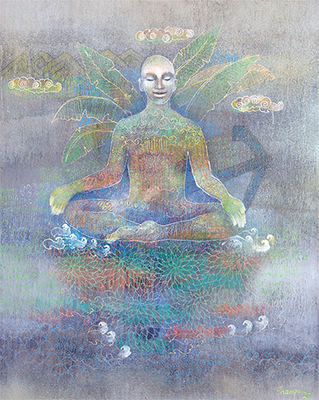There is a certain stillness about Shampa Sircar Das’s work, that one may feel, but not quite be able to put in words. The imageries, amorphous and fluid, carry in them so many stories and metaphors of the past, present, and future; yet they sustain just as much silence. The spontaneity with which the human and animal forms appear in her paintings and interact with the sundry elements of nature, it is as if her motifs never begin nor end. Her canvas only offers to be the aether, on which these varied creations wilfully occur, resonate, and dispel. On this note is born “Pravah,” her newest series of artworks.

The Sanskrit term Dashavatar means ten avatars, incarnations of
Vishnu. The chronology of these incarnations clearly illustrates the
evolutionary process of mankind.
The idea of evolution of mankind, which is inherent in the theory of
avatars, was visualised by the sages in India, thousands of years before
it was formally proposed, in the middle of the nineteenth century, by
the British naturalist Charles Darwin.
In Hindu theology an idea is generally presented, not as a dry piece of
philosophy; but as a series of symbolic, mythological and moralistic
stories. A thought becomes easy to understand and teaching becomes
more palatable if the same is explained through simple stories and
interesting anecdotes. Following that tradition, the theory of evolution
was presented in the form of dashavatar - a set of tales which had
religious, mythological, moralistic and spiritual flavour.

Copyright © Shampa Sircar Das